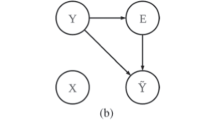Abstract
Learning from labelled data is becoming more and more challenging due to inherent imperfection of training labels. Existing label noise-tolerant learning machines were primarily designed to tackle class-conditional noise which occurs at random, independently from input instances. However, relatively less attention was given to a more general type of label noise which is influenced by input features. In this paper, we try to address the problem of learning a classifier in the presence of instance-dependent label noise by developing a novel label noise model which is expected to capture the variation of label noise rate within a class. This is accomplished by adopting a probability density function of a mixture of Gaussians to approximate the label flipping probabilities. Experimental results demonstrate the effectiveness of the proposed method over existing approaches.







Similar content being viewed by others
Notes
We used LIBLINEAR [31] in this study.
References
Beigman E, Klebanov BB (2009) Learning with annotation noise. In: ACL 2009, Proceedings of the 47th annual meeting of the association for computational linguistics, 2–7 August 2009, Singapore, pp 280–287
Kolcz A, Cormack GV (2009) Genre-based decomposition of email class noise. In: SIGKDD’09, pp 427–436
Johnson BA, Iizuka K (2016) Integrating openstreetmap crowdsourced data and landsat time-series imagery for rapid land use/land cover (LULC) mapping: case study of the laguna de bay area of the philippines. Appl Geogr 67:140–149
Snow R, O’Connor B, Jurafsky D, Ng AY (2008) Cheap and fast—but is it good? Evaluating non-expert annotations for natural language tasks. In: EMNLP, pp 254–263
Shen D, Ruvini J-D, Sarwar B (2012) Large-scale item categorization for e-commerce. In: Proceedings of the 21st ACM international conference on information and knowledge management, CIKM ’12, New York, NY, USA. ACM, pp 595–604
Xiao T, Xia T, Yang Y, Huang C, Wang X (2015) Learning from massive noisy labeled data for image classification. In: Proceedings of the IEEE conference on computer vision and pattern recognition, pp 2691–2699
Frénay B, Verleysen M (2014) Classification in the presence of label noise: a survey. IEEE Trans Neural Netw Learn Syst 25(5):845–869
Menon AK, van Rooyen B, Natarajan N (2016) Learning from binary labels with instance-dependent corruption. arXiv preprint arXiv:1605.00751
Biggio B, Nelson B, Laskov P (2011) Support vector machines under adversarial label noise. In: ACML, volume 20 of JMLR proceedings, pp 97–112. JMLR.org
Chhikara RS, McKeon J (1984) Linear discriminant analysis with misallocation in training samples. J Am Stat Assoc 79(388):899–906
Lawrence ND, Schölkopf B (2001) Estimating a Kernel fisher discriminant in the presence of label noise. In: ICML’01. Morgan Kaufmann, pp 306–313
Li Y, Wessels LFA, de Ridder D, Reinders MJT (2007) Classification in the presence of class noise using a probabilistic kernel Fisher method. Pattern Recognit 40(12):3349–3357
Raykar VC, Shipeng Y, Zhao LH, Valadez GH, Florin C, Bogoni L, Moy L (2010) Learning from crowds. J Mach Learn Res 11:1297–1322
Bootkrajang J, Kabán A (2012) Label-noise robust logistic regression and its applications. In: ECML-PKDD’12, pp 143–158
Bootkrajang J, Kabán A (2014) Learning kernel logistic regression in the presence of class label noise. Pattern Recognit 47(11):3641–3655
Lugosi G (1992) Learning with an unreliable teacher. Pattern Recognit 25:79–87
Long PM, Servedio RA (2010) Random classification noise defeats all convex potential boosters. Mach Learn 78(3):287–304
Natarajan N, Dhillon IS, Ravikumar PK, Tewari A (2013) Learning with noisy labels. In: NIPS’13, pp 1196–1204
Manwani N, Sastry PS (2013) Noise tolerance under risk minimization. IEEE Trans Cybernet 43(3):1146–1151
Ghosh A, Manwani N, Sastry PS (2015) Making risk minimization tolerant to label noise. Neurocomputing 160:93–107
Lachenbruch PA (1974) Discriminant analysis when the initial samples are misclassified II: non-random misclassification models. Technometrics 16(3):419–424
Bootkrajang J (2016) A generalised label noise model for classification in the presence of annotation errors. Neurocomputing 192:61–71
Du J, Cai Z (2015) Modelling class noise with symmetric and asymmetric distributions. In: AAAI, pp 2589–2595
Schmidt M (2005) minFunc: unconstrained differentiable multivariate optimization in matlab. http://www.cs.ubc.ca/~schmidtm/Software/minFunc.html
Chen Y, Ye X (2011) Projection onto a simplex. arXiv preprint arXiv:1101.6081
West M, Blanchette C, Dressman H, Huang E, Ishida S, Spang R, Zuzan H, Olson JA Jr, Marks JR, Nevins JR (2001) Predicting the clinical status of human breast cancer by using gene expression profiles. Proc Natl Acad Sci USA 98(20):11462–11467
Alon U, Barkai N, Notterman DA, Gishdagger K, Ybarradagger S, Mackdagger D, Levine AJ (1999) Broad patterns of gene expression revealed by clustering analysis of tumor and normal colon tissues probed by oligonucleotide arrays. Proc Natl Acad Sci USA 96(12):6745–6750
Golub TR, Slonim DK, Tamayo P, Huard C, Gaasenbeek M, Mesirov JP, Coller H, Loh ML, Downing JR, Caligiuri MA, Bloomfield CD (1999) Molecular classification of cancer: class discovery and class prediction by gene expression monitoring. Science 286:531–537
Dua D, Karra Taniskidou E (2017) UCI Machine Learning Repository. University of California, School of Information and Computer Science, Irvine, CA. http://archive.ics.uci.edu/ml
Demšar J (2006) Statistical comparisons of classifiers over multiple data sets. J Mach Learn Res 7:1–30
Fan R-E, Chang K-W, Hsieh C-J, Wang X-R, Lin C-J (2008) LIBLINEAR: a library for large linear classification. J Mach Learn Res 9:1871–1874
Acknowledgements
The authors would like to thank anonymous reviewers for constructive comments. This research is financially supported by the Thailand Research Fund (Grant No. MRG59080235). Department of Computer Science, Faculty of Science at Chiang Mai University provides research and computing facilities.
Author information
Authors and Affiliations
Corresponding author
Rights and permissions
About this article
Cite this article
Bootkrajang, J., Chaijaruwanich, J. Towards instance-dependent label noise-tolerant classification: a probabilistic approach. Pattern Anal Applic 23, 95–111 (2020). https://doi.org/10.1007/s10044-018-0750-z
Received:
Accepted:
Published:
Issue Date:
DOI: https://doi.org/10.1007/s10044-018-0750-z




